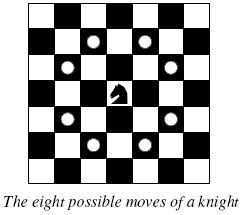poj 2488 A Knight's Journey(dfs)
Description
 Background
Background The knight is getting bored of seeing the same black and white squares again and again and has decided to make a journey
around the world. Whenever a knight moves, it is two squares in one direction and one square perpendicular to this. The world of a knight is the chessboard he is living on. Our knight lives on a chessboard that has a smaller area than a regular 8 * 8 board, but it is still rectangular. Can you help this adventurous knight to make travel plans?
Problem
Find a path such that the knight visits every square once. The knight can start and end on any square of the board.
Input
The input begins with a positive integer n in the first line. The following lines contain n test cases. Each test case consists of a single line with two positive integers p and q, such that 1 <= p * q <= 26. This represents a p * q chessboard, where p describes how many different square numbers 1, . . . , p exist, q describes how many different square letters exist. These are the first q letters of the Latin alphabet: A, . . .
Output
The output for every scenario begins with a line containing "Scenario #i:", where i is the number of the scenario starting at 1. Then print a single line containing the lexicographically first path that visits all squares of the chessboard with knight moves followed by an empty line. The path should be given on a single line by concatenating the names of the visited squares. Each square name consists of a capital letter followed by a number.
If no such path exist, you should output impossible on a single line.
If no such path exist, you should output impossible on a single line.
Sample Input
3 1 1 2 3 4 3
Sample Output
Scenario #1: A1 Scenario #2: impossible Scenario #3: A1B3C1A2B4C2A3B1C3A4B2C4
描述:就是从p行q列的棋盘上的某一点出发,列用A,B……表示,行用1,2,3……表示。然后每次只能走“日”字,和象棋中的马一样,问能不能在不重复的情况下遍历棋盘。能的话就按字典序输出遍历的路径,其中输出格式为先列后行,不能的话就输出impossible。
解析:既然遍历该棋盘,并且按字典序输出。那就从最左上角A1开始进行DFS遍历。要注意的是按字典序输出,所以遍历时的顺序很重要,按从上到下,从左到右的顺序遍历。
Java AC代码
import java.util.Scanner; public class Main { static Point path[]; //记录遍历路径 static boolean[][] marked; //访问过则为true,未访问过则为false static int dx[] = {-2, -2, -1, -1, 1, 1, 2, 2}; //八个方向的列值的变化 static int dy[] = {-1, 1, -2, 2, -2, 2, -1, 1}; //八个方向的行值的变化 static int p,q; public static boolean dfs(int row, int col, int step) { marked[row][col] = true; path[step] = new Point(row, col); //第step步 访问的是(row,col)这个点 if(step == p * q) //递归出口,因为一共只有p*q个点,当访问步数等于p*q时,说明所有点都已经访问过了,找到了结果,返回true return true; for(int i = 0; i < 8; i++) { int _col = col + dx[i]; int _row = row + dy[i]; if(_row >=1 && _row <= p && _col >=1 && _col <=q && !marked[_row][_col]) { if(dfs(_row, _col, step + 1)) return true; } } marked[row][col] = false; //到这说明从(row,col)这个点出去的深搜都失败了,所以访问位设置为false,返回上一个点进行其他的深搜 return false; } public static void main(String[] args) { Scanner sc = new Scanner(System.in); int n = sc.nextInt(); int input[] = new int[2 * n + 1]; //把输入的数都保存在数组里 int cases = 0; int index = 1; for(int i = 1; i <= 2 * n; i++) { input[i] = sc.nextInt(); } while(n > 0) { marked = new boolean[27][27]; p = input[index]; q = input[index + 1]; path = new Point[p * q + 1]; cases++; System.out.println("Scenario #" + cases + ":"); boolean flag = dfs(1, 1, 1); if(flag) { //成功遍历时的输出 for(int i = 1; i <= p * q; i++) { System.out.print((char)(path[i].column - 1 + 'A')); System.out.print(path[i].row); } System.out.print("\n"); } else { //失败的输出 System.out.println("impossible"); } if(n != 0) System.out.print("\n"); n--; index = index + 2; } } } class Point { public int row; public int column; public Point(int row, int column) { this.row = row; this.column = column; } }




